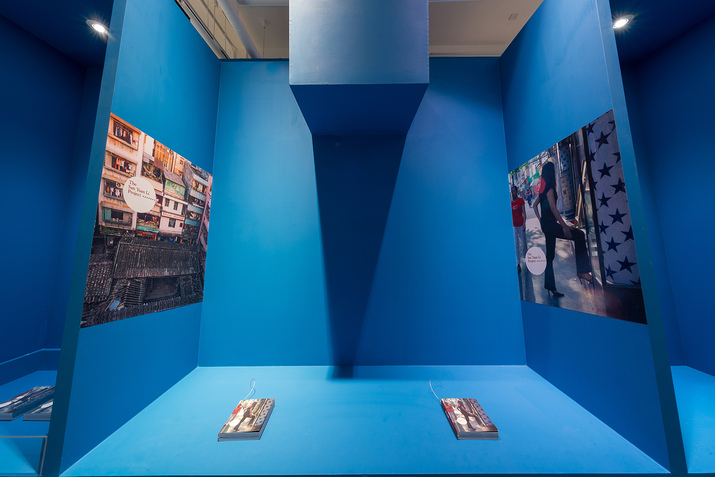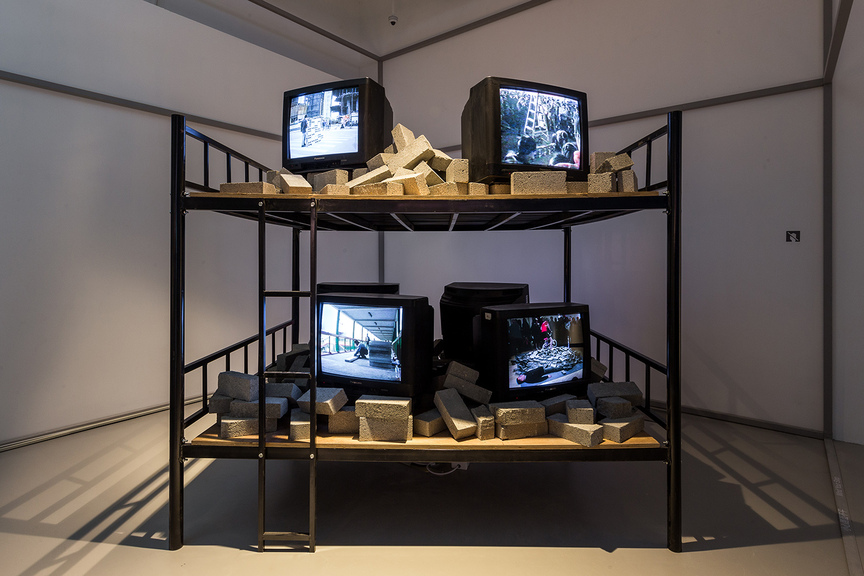-
From Current Issue
-
- Editor’s Letter Fire in the Heart
- Reviews I Gusti Ayu Kadek Murniasih
- Reviews 11th Seoul Mediacity Biennale: “One Escape at a Time”
- Dispatch Networked China
- One on One Monira Al Qadiri on Yukio Mishima
- Essays The rise of independent art spaces in pandemic-era Shanghai
- Features Tuan Andrew Nguyen
- Table of Contents
- Web Exclusives
- Archive
- Subscribe

R
E
V N
E
X
T
The restaging of “Canton Express,” inspired by “the temporary construction commonly seen on the side of the road around the Pearl River Delta,” fit snugly into its venue. Held in the M+ Pavilion at the West Kowloon Cultural District, the building with a reflective exterior stood in the midst of a vast construction site next to Hong Kong’s harbor. “Canton Express” was first curated for the 50th Venice Biennale in 2003, showcasing Cantonese contemporary artists from the Pearl River Delta region—the frontier of China’s urbanization, modernization, industrialization and globalization after economic reform in the 1980s. Witnessing the rapid changes of China’s coastal cities, Chinese artists preserved their testimonies in their artwork and reflected on the aforementioned topics, at times referencing or utilizing simple, everyday objects.
San Yuan Li (2003) is an experimental film by U-thèque that depicts a montage of the unique phenomenon of “urban villages” in China. In the monochromatic film, we see villagers struggling to strike a balance between the contradictory identities in San Yuan Li—a rural village that exists in the shadow of modernized Guangzhou. The film shows how agricultural activities, as well as industrial activities such as newspaper printing, moved to rooftops, with planes buzzing over them. This consequence of rapid urbanization can still be found in various locations in China, even over a decade after this video was filmed.
DUAN JIANYU, Artistic Chickens, 2013, fiberglass, resin, acrylic paint, steel armature. Courtesy M+, Hong Kong.
At a corner of the exhibition hall, a group of fiberglass chicken figures seemed to be living in their own world in an invisible barn, with the sculptural installation exploring the agricultural roots of Canton, known today as Guangdong. These lifelike chicken figures are the last survivors of the original “Canton Express” exhibition artwork Artistic Chickens (2003) by Duan Jianyu. For its first presentation, a hundred of these chicken sculptures were “scattered throughout other areas of the exhibition” for an authentic depiction of the free range chickens favored by the food-loving Cantonese.
The floor plan in M+ was set up almost identical to the original in 2003, which was designed to resemble a commercial street, commonly found in and around Guangzhou in the 90s. Walking into one of the “houses” on the “street” took viewers into Zheng Guogu’s Sample Room (2003), which resembled a kitchenware display room. Colorful pieces of plastic kitchenware were hung all over the room, and walls were covered with excerpts from the email correspondence between the artist and Hou Hanru, curator of the original “Canton Express” exhibition, as an imitation of how these manufacturing industries communicate with their overseas buyers. Zheng explores the region’s industrialization and globalization after the economic reform around the 1980s by showing the exporting manufacturing industry of Yangjiang, where the artist was born and raised.
Urbanization and modernization of the Pearl River Delta region is also portrayed through the use of material in Lin Yilin’s installation Hotbed (2003/2017), consisting of a metal bunk bed, six bulky televisions and grey bricks. According to Lin, he first started using bricks because it was a cheap, accessible material during the city’s urban renewal, when old buildings were torn down, yielding a profusion of spare bricks. The televisions play Lin’s performance art pieces, including one enacted in Hong Kong in 1996, a year before the handover from British colonial rule to Chinese sovereignty, in which Lin wrote the names of Hong Kong political parties on a brick wall, and moved the wall forward brick by brick, When the whole act was over, the re-formed Chinese character fragments no longer made sense. This video was shown again in “Canton Express” at M+ Pavilion, coinciding with the 20th anniversary of Hong Kong’s handover, inviting the audience to contemplate how Hong Kong has changed since the transition in its governance.
At the M+ Pavilion, “Canton Express” presented screenshots of China’s growth in the past few decades, focusing on different aspects of life in the ever-evolving Pearl River Delta region. “Canton Express” was also an express train traveling on the rails of China’s growth under globalization and urbanization in the recent decades. Whether you are a clueless tourist, or a traveler looking back at your hometown, the journey has something to offer for everyone.
“Canton Express” is on view at the M+ Pavilion, Hong Kong, until September 10, 2017.
To read more of ArtAsiaPacific’s articles, visit our Digital Library.







